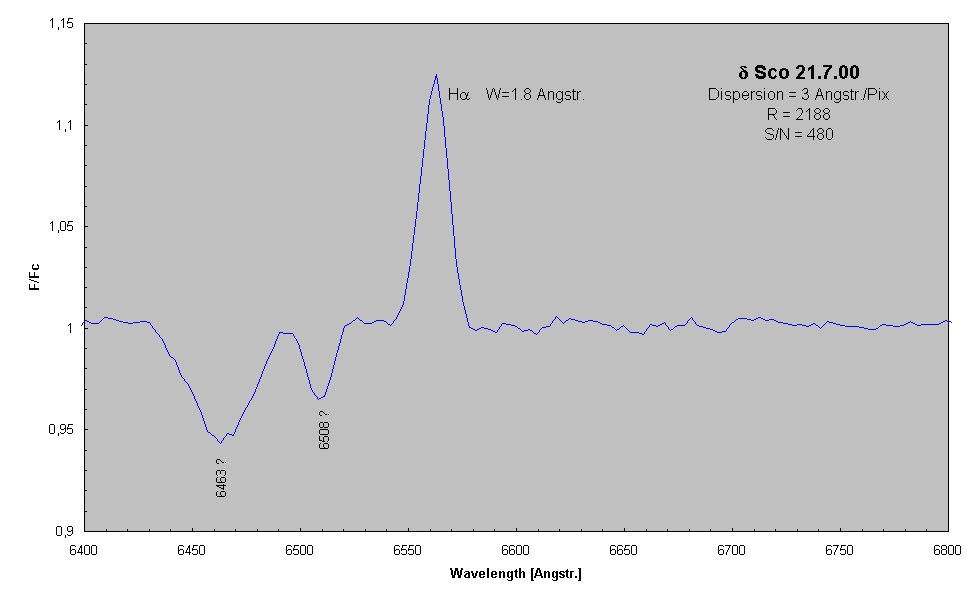Delta Sco: Historical brightening!
Discovery of the brightest gamma Cas-type variable
S. Otero discovered that the bright B-type star Delta Sco is
brighter than its normal. He reported it looked 2.2mag instead of 2.3mag
on July 8, and suggested it is a possible gamma Cas (GCAS) variable
(active Be stars)
(vsnet-be 2).
The spectroscopic confirmation
that it is a new GCAS star, was reported in
[vsnet-be 3] and IAUC 7461:
Spectra taken with the 1.3m telescope at Skinakas Observatory (Crete, Greece)
on July 19 revealed the H-alpha line in emission. The bright star
delta Scorpii was in a major optical and H-alpha outburst
(vsnet-campaign-be 2).
Delta Sco has now become one of the brightest GCAS stars among
historically recorded outbursts of this class.

(Spectrum taken by E. Pollmann; vsnet-campaign-image 2,vsnet-campaign-be 8)

(High-dispersion spectrum presented by S. Masuda; vsnet-campaign-be 15)
S. Otero reported that J. Fabregat (University of Valencia, Spain) informed
that he has been receiving several spectra which showed the emission lines
have been present, although with variable strength, for at least five years.
This indicates we're not witnessing the birth of delta Sco as a Be star but
its birth as a gamma Cas variable
(vsnet-campaign-be 9).
E. Pollmann reported the equivalent width of H-alpha line on July 30
to be 1.9 and 1.6 A derived from the two spectra
(vsnet-campaign-be 21).
M. Gavin presented a spectrum of Delta Sco at
http://www.astroman.fsnet.co.uk/emission2.htm
(vsnet-campaign-be 36).
Occultation prediction
T. Kato forwarded a D. Dunham's report that
the next occultation of delta Scorpii occur on 2003 September 2,
and the other days are listed in
[vsnet-campaign-be 14].
Fading, and re-brighteining
R. Wilson reported the magnitude estimation during early phase of the event.
He and G. Crossley estimated the magnitude on July 16 to be between
2.1 and 2.3 using the slides displayed by B. Bridge in the Astronomical
Association of Queensland
(vsnet-campaign-be 39).
Gradual fading trend was seen from August
(vsnet-campaign-be 34).
In the early September, S. Otero reported it seemed to be fading a little
faster
(vsnet-campaign-be 50).
And then, the magnitude remained almost constant around mid-September
at about 2.1mag
(vsnet-campaign-be 55,
vsnet-campaign-be 56).
The gradual fading and small plateau were
interrupted by a surprising re-brightening; September 25.7, 2.03mag
(B. Fraser) and September 26, 2.06mag (S. Otero)
(vsnet-campaign-be 61,
vsnet-campaign-be 62).
During the re-brightening, S. Otero reported that the star became
brighter than ever before (October 4, 1.86mag;
vsnet-campaign-be 64,
vsnet-campaign-be 67,
vsnet-campaign-be 68).
S. Otero found that taking the orbital period from Fabregat, Reig and
Tarasov (2000) P= 10.583yr and the ephemeris from Hartkopf et al.,(1996)
To = 1979.41 , a periastron passage had taken place in 1958.24, and
the star was measured brighter than normal in 1958. He also commented
it's a very good indicator of the relation between the binary nature of
the system and the observed events
(vsnet-campaign-be 71).
Light curve presented by S. Otero:
vsnet-campaign-be 65
 Return to HomePage
Return to HomePage
 Return to Daisaku Nogami's page
Return to Daisaku Nogami's page
vsnet-adm@kusastro.kyoto-u.ac.jp
Powered by ooruri technology




 Return to Daisaku Nogami's page
Return to Daisaku Nogami's page